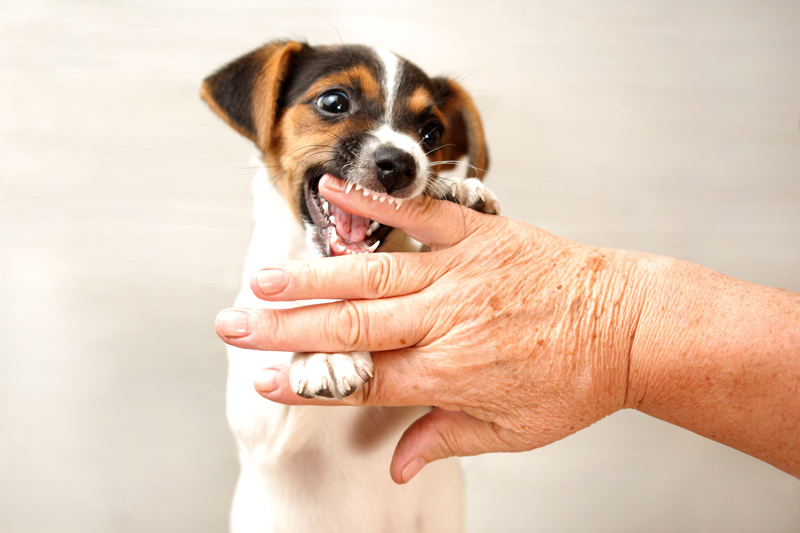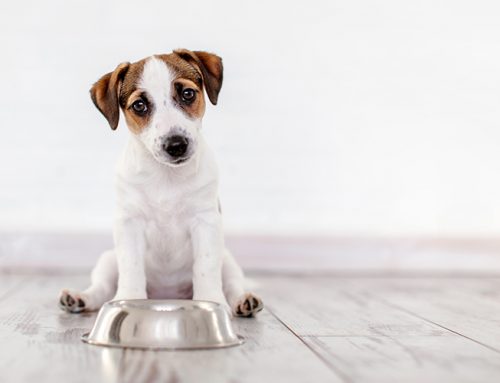Puppies normally have healthy and robust appetites. They explore the world with their nose, ears, and sometimes, much to a new pet owner’s chagrin, their mouths. Puppies like to taste the grossest things imaginable — slugs, dirt, poop, garbage.
It can be a shock when a normally ravenous puppy refuses to eat the meal you thoughtfully prepared for them. If the behavior is sudden and accompanied by other symptoms — diarrhea, vomiting, lethargy, excessive panting or drooling or anything else unusual — contact your vet immediately. It’s possible your puppy is feeling ill, picked up a bacteria, or ate something toxic.
As long as your dog is otherwise healthy, growing, and maintaining a healthy body conditioning score, there’s probably not cause for serious concern. You can always consult with your vet, breeder, or rescue facility for advice.
After all, there are plenty of nonmedical reasons your puppy may refuse to eat or doesn’t eat as often as you expect.
Your puppy is adjusting to its new home
If you’ve just brought your new dog home, it may be too stressed or anxious or frightened in its new situation to eat. It’s not unusual for a dog to skip a meal or two when it’s in a new environment. Try encouraging your puppy to eat by sitting with it near its meal bowl or by offering it some food from your hand. Sometimes, once their appetite gets going they’ll dive into their bowl. If your puppy is still drinking water and willing to munch a treat or two, you can give it a day or two and see if it makes a difference. You can also try giving it a food that’s irresistible — some home-cooked chicken and rice or sweet potato. Once your puppy has settled in, give regular food a try again.
Your puppy might be full
If you’re adjusting to a new food or still determining the right serving size, your puppy may just not be hungry.
“If your puppy occasionally skips a meal or picks at its food, don’t worry,” the American Kennel Club says on its website. “It could mean she is ready to eliminate a feeding or that you have given her too much, in which case simply reduce the quantity served.”
Sometimes the recommended serving size on food packages is too large for a specific puppy and you can cut back.
If your pup is routinely leaving behind part of its meals in its bowl, you try reducing portion sizes. As long as your puppy maintains a healthy body conditioning score, there’s no need to worry about giving him or her more food.
Your puppy might not like the food you’ve selected
If you’ve recently brought your puppy home from a breeder or rescue and are trying out a new type of food, your dog may not like your choice. Maybe it’s an unfamiliar texture or protein. Or maybe your pup simply doesn’t enjoy the taste.
If it is a new food, the best way to introduce it is to mix it in with a food your puppy is already familiar with. Start with 25 percent new food, 75 percent old food, and gradually increase the new food percentage until your puppy is switched over.
If you’ve gone from wet to dry or dry to wet or switched to raw or dehydrated, you still should consider transitioning slowly, especially if your dog is ignoring the new food. A transition period also helps your dog’s digestive tract and tummy adjust to the new food without an upset stomach.
Still won’t eat but is otherwise healthy? Try a different type of food, one that’s more familiar, or one that provides a different texture. Some dogs, for example, don’t like fishy moist food and would prefer dry chicken. Some dogs don’t like pumpkin or carrot. There may be an ingredient in your food your dog just doesn’t have a taste for.
The food is spoiled
Dry dog food can last a long time, but it does go bad. Make sure you know the expiration date of your puppy’s food. Keep it in a cool, dry place, and if the food smells off to you, or contains mold or bugs, get rid of it. Don’t feed it to your dog, who may get an upset stomach from eating rotten food.
Your puppy is teething
Puppies can lose their appetites when they are teething — especially when their canines, premolars, and molars are coming in. Teething may come with an upset tummy, low-grade fever, and soft stools. Try a warm, soft food, or soften dehydrated or kibble with water if your puppy is teething. The teething phase should only last a week or two.
Puppies start losing their baby teeth at around eight weeks old, and their adult teeth should be fully grown in by around eight months old.
If your puppy is refusing to eat and is around three or four months old, teething could explain the lack of interest in food. If you’re finding a little bit of blood on your dog’s beloved chew toys, there’s a good chance it’s teething. Swollen gums, slow eating, and increased drooling are also symptoms.

Your puppy may have an upset tummy
Dogs can feel nauseated or have an upset stomach just like humans. It might put your dog off its dinner for a meal or two. Dogs can feel ill from:
- New medications or antibiotics
- Recent vaccinations
- Parasites
- Bacteria
- Eating something rotten (or getting into the garbage)
- Food sensitivities
- Serious illness (check with a vet if your puppy continues to refuse to eat, or has multiple symptoms).
- Pain (from an injury, inflammation, or even impacted anal glands)
Humans don’t like to eat when they’re feeling ill, so it makes sense that dogs don’t either.
Your dog might need to work up an appetite
If your puppy isn’t getting enough playtime or exercise, it might not feel hungry. It’s important to make sure your puppy is using its body and brain. Tugging games, toys, playtime with other puppies, short walks, and playtime with you, can help a puppy build up an appetite.
Other possible reasons your pup won’t eat
- It needs a different meal schedule to fit with when he or she is hungry.
- Change in routine (your dog should start eating again when it has adjusted).
- Change in their environment (added a new pet, reorganized a room, moved recently?).
- The new food isn’t appealing.
- Owner absence (maybe your pup only eats when you’re home, or the rest of its “pack” is home).
- Too many treats. Your dog may be holding out for a more tasty treat and think if it doesn’t eat its dinner, it may get a treat instead. Or maybe the treats have made regular food unappetizing.
- Your puppy’s mouth is sore. It’s possible it hurt its tongue, gums, or teeth while exploring the world with its mouth. Take a quick look at your puppy’s mouth and feel around gently to see if there are any visible injuries.
- Your dog doesn’t like its bowl or is afraid of its bowl. You may need to try a different shape, material, or size.
- It’s too warm in the house. Dogs can lose their appetites in hot weather.
What can you do to convince your puppy to eat?
First, consider your pet’s health. If your puppy seems healthy and has no serious symptoms, you can wait a day or two before making a vet appointment. As long as your puppy is maintaining a healthy body weight and still drinking water, you can experiment with some new mealtime tactics.
- Try a different bowl.
- Try a different mealtime.
- Make dinner more appealing (try pouring unsalted bone broth on dinner).
- Heat up your puppy’s food for a few seconds in the microwave.
- Make sure the food you’re offering isn’t spoiled.
- Cut back on treats, or use your puppy’s regular food as a treat.
- Rule out food allergies.
- Try a different type of food.
- Make sure your puppy is getting age and breed appropriate amounts of exercise.
- Don’t give your puppy table scraps. It could be holding out for food off your plate.
- Check in with your vet or breeder.
- Get a food-dispensing toy — fun, educational, and rewarding for your puppy.
- If your puppy is teething, try frozen treats to soothe sore gums.
- Try hand feeding your puppy for a short period.







